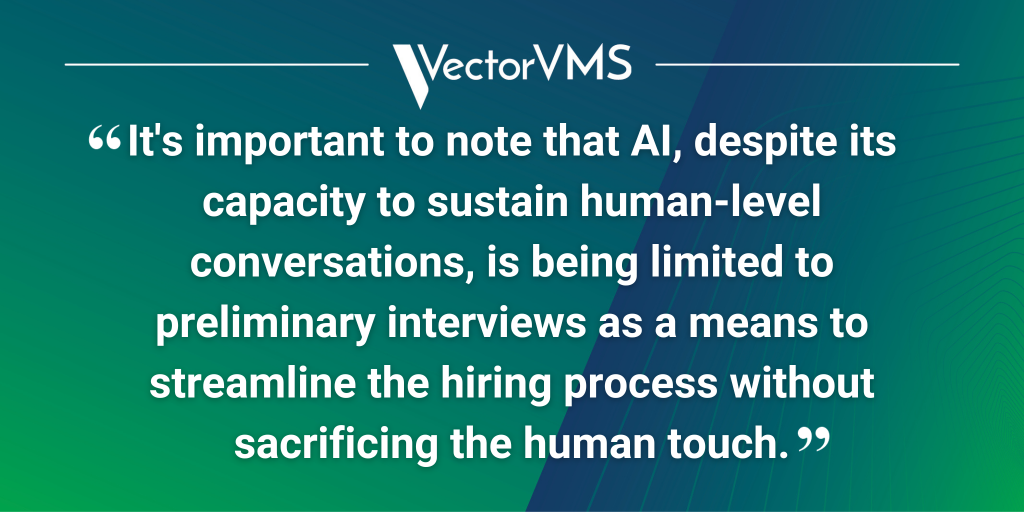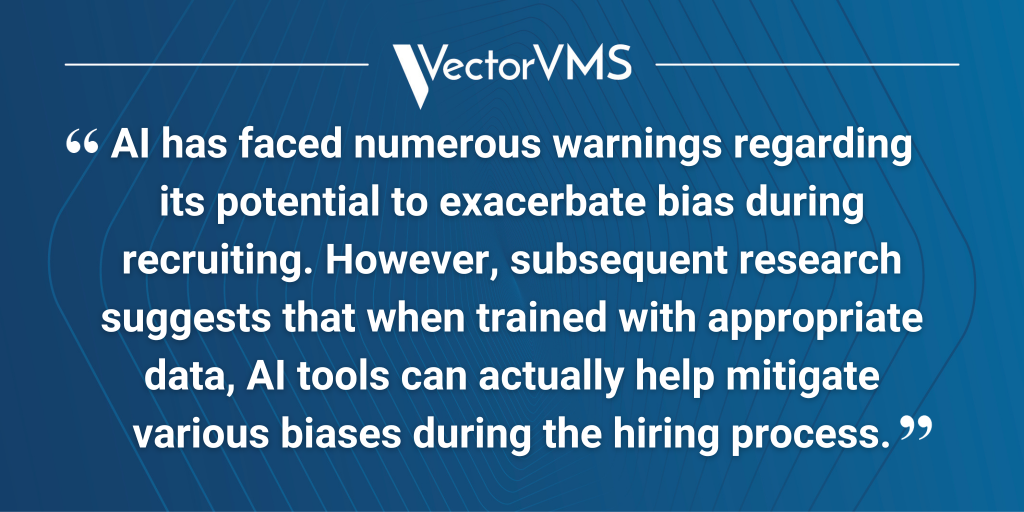Technology evolves at an often unpredictable pace—it’s imperative for HR professionals to stay informed and engaged in discussions about emerging tools. Artificial intelligence (AI) is a great example: although present in many HR tools for years, it has recently reached a level that calls for a thorough examination of its new capabilities.
Let’s explore how AI applications are transforming workforce management and gain insight into how to leverage its benefits.
The Rise in AI-Powered Tools
AI usage is already established in many industries, and HR is no exception. At the end of 2023, a survey from Gartner found that 81% of HR leaders have explored or implemented AI solutions to improve process efficiency within their organizations.
Another study from the same period found that 94% of staffing firms expect to use AI in some form over the next five years. Additionally, 80% of respondents believe AI will have a positive impact on their business.
A subsequent survey of cross-industry experts found that within the next three years, 39% of today’s manual staffing tasks are likely to be performed by AI. Moreover, within the same time period, 80% or more of the experts surveyed expected critical AI adoption in:
- Candidate screening and skills assessment
- Matching and selection
- Redeployment
The following are the most common applications for AI within HR:
1) Sourcing Candidates
As highlighted by Gartner, AI can expedite the traditionally slow hiring process by:
- Compiling requirements from stakeholders and initiating new requests with suppliers through a VMS.
- Generating descriptive text for job postings, including skill descriptions or typical tasks associated with those skills.
- Providing support and guidance to applicants.
- Scheduling interviews with hiring managers.
2) Screening Candidates and Assessment:
AI algorithms can analyze resumes, identify the most qualified applicants, and provide information to assist recruiters in making better hiring decisions. Furthermore, some AI tools incorporate assessment technology to simulate tasks that applicants would perform in a role, ensuring they are indeed a good fit.
Moreover, Gartner suggests that organizations can use an internal talent marketplace powered by AI to post a job position and instantly generate multiple matches. That said, it’s important to note that to achieve better matching or assessment, you need to populate your AI-driven system with appropriate information. The more relevant information it contains, the more accurately it can identify gaps between skills availability and skills needs.
YOU MIGHT ALSO LIKE | ‘3 Signs That AI-Powered Recruiting Tools Are Improving Your Talent Acquisition Program’

3) Preliminary Interviews
Given the capacity of chatbots powered by large language models (LLMs) to engage in human conversational interactions, the concept of AI conducting interviews with applicants is no longer surprising. A 2023 survey conducted by Resume Builder projected that by 2024, 43% of companies would use AI for job interviews.
Many current AI-interviewing tools operate by requesting video responses to written questions displayed on applicants’ screens. AI algorithms analyze various aspects of the video responses and provide a transcript, along with a report summarizing the candidate’s performance, to the recruiter.
The advantage of this approach is the time and cost savings achieved by screening significantly more applicants with significantly fewer resources. However, it’s important to acknowledge that AI, despite its capacity to sustain human-level conversations, is being limited to preliminary interviews as a means to streamline the hiring process without sacrificing the human touch.
As highlighted by the University of Southern California, humans comprehend concepts such as integrity, ethics, and morality in ways that AI can’t. Plus, only humans are capable of discerning nuances that demonstrate empathy or highly developed interpersonal skills, which are invaluable in any work environment.
4) Employee Onboarding
AI can streamline time-consuming tasks in the onboarding process through the use of chatbots powered by LLMs. Chatbots can assist new employees by answering questions, providing information, and sending reminders about key documents. Plus, AI can personalize the onboarding experience by analyzing data on each employee, such as their skills and preferences, and tailoring their training accordingly.
Bernard Marr, futurist and author, discussed this topic in Forbes and pointed out some of the onboarding tasks that can be automated using AI:
- Digitally generating and managing paperwork
- Automatically sending messages to employees during their onboarding process
- Monitoring compliance with mandatory training and document submissions
- Compiling reports on onboarding trends and patterns
Bernard also asserts that the benefits of an AI-powered onboarding experience can extend far beyond the administrative workload, fostering a sense of welcome, engagement, and investment from day one for new hires.

What Are the Main Benefits of AI in HR?
1) Increased Efficiency
AI can take on routine task work. As IBM states, AI can also serve as a valuable source of data sets for reviewing processes to make more informed decisions or streamline HR tasks. Beyond that, it can analyze the outcomes of recruiting efforts, enabling recruiters and hiring managers to identify and refine their most successful outreach strategies (or develop new ones).
2) Reduced Hiring Bias
AI has faced numerous warnings regarding its potential to exacerbate bias during recruiting. However, subsequent research suggests that when trained with appropriate data, AI tools can actually help mitigate various biases during the hiring process.
Employers using generative AI in recruitment should be mindful of their data sources and quality. If the data is derived from past HR decisions influenced by biases, it may indeed perpetuate and replicate such behavior. On the other hand, by deliberately incorporating a diverse range of inclusive perspectives into their training data, organizations can promote the creation of more inclusive working environments.
3) Higher Candidate Quality
The capability of AI engines to screen for keywords during applications can help determine a better fit for both candidates and businesses. Additionally, AI can be used to strategically target top talent by analyzing the online activities of potential candidates.
Moreover, these AI tools can enhance their accuracy by automatically integrating external data, making it easier to identify emerging skills and areas with the highest competition for them. Plus, AI can analyze historical data on both successful and unsuccessful hires to identify patterns and characteristics that contribute to successful outcomes.
LEARN MORE ABOUT DIVERSITY | ‘2 Reasons Why DE&I Should Lead Your Contingent Workforce Planning by 2024’
Remaining Aware of AI Limitations
Despite AI’s benefits, it’s important to recognize that there’s still a need for human intervention in the world of recruitment. AI can’t think with the same nuances as a recruiter, and on its own, it can’t provide a complete picture of an applicant’s situation. For instance, gaps in resumes may indicate legitimate life events such as pregnancy, military deployment, or illness. However, a resume can be automatically screened out by an AI-powered ATS or recruitment management system (RMS) based on resume gaps alone.
As such, Gartner recommends establishing governance systems to oversee the output of AI engines to enhance quality and ensure there’s space for human feedback to correct and refine the tool over time.
Moreover, with an increasing number of corporations using AI to store business information or sharing data with AI tools like ChatGPT during their tasks, data security is now more critical than ever. Organizations must establish robust cybersecurity guidelines to prevent any data breaches by employees.
Want to learn about further key trends that will help you build a future-proof workforce? Download our ebook ‘The Top 5 Macro Trends Driving Workforce Management in 2024’. Alternatively, contact us or request a demo to witness VectorVMS features in action!
 Meet the Expert
Meet the Expert
Taylor Ramchandani – VP of Strategy
Taylor Ramchandani is responsible for the management and strategic planning of the VectorVMS vendor management system. Taylor is committed to client satisfaction and to ensuring VectorVMS technology meets the current and future needs of clients and managed service providers (MSPs). She uses market research and in-depth industry experience to create products and services that make extended workforce management efficient and intuitive. Taylor oversees product development, marketing, and business partnerships for VectorVMS and is responsible for driving innovation for contingent workforce management. Connect with her on LinkedIn.



